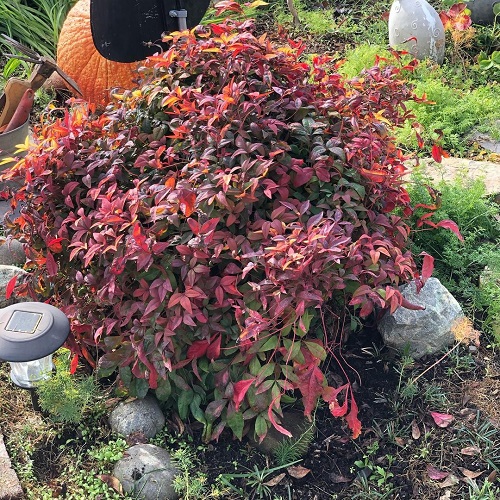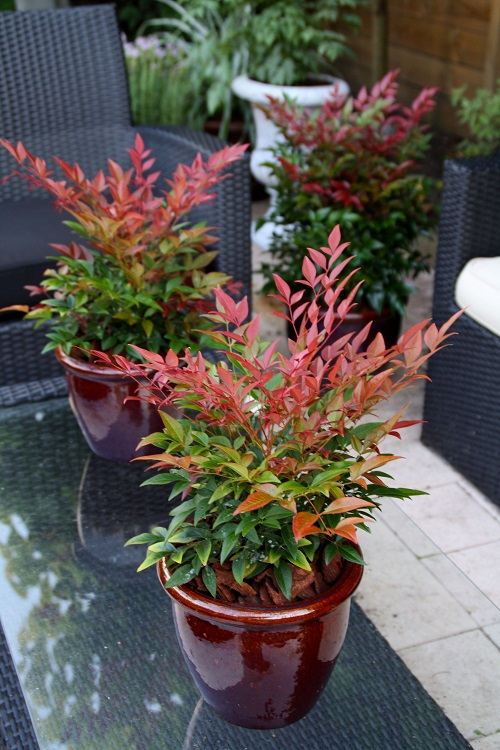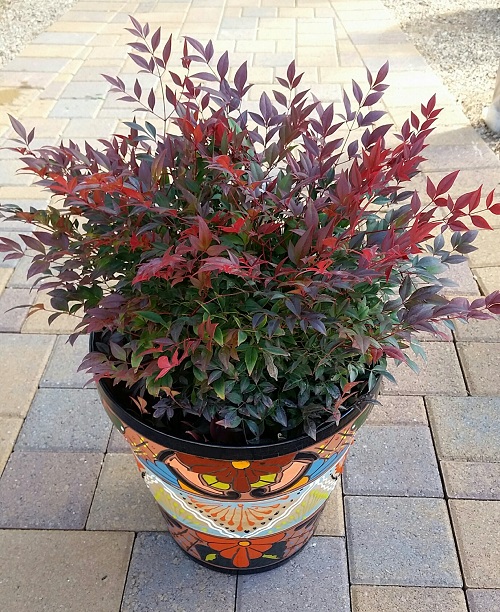Gulf Stream Nandina – a plant that truly reflects “heavenly’ in its name! Here’s how to grow and care for this vivid bamboo!
Gulf Stream Nandina – a captivating plant whose fiery red foliage and lush, compact form create a spectacle in any landscape. What’s more? It also makes for a cute indoor plant!
USDA Zones: 6-10
Botanical Name: Nandina domestica ‘Gulf Stream’
Philodendron Green Princess Care and Growing Guide
Gulf Stream Nandina Information
Gulf Stream Nandina is a cultivar of the Nandina domestica species, which is native to East Asia. This particular cultivar has been developed for its ornamental features and is a popular choice in various landscaping applications.
Appearance
Gulf Stream Nandina is a compact, evergreen shrub that usually reaches a height and width of around 3 to 4 feet. It features lanceolate leaves that are divided into many leaflets, providing a feathery, bamboo-like appearance.
One of the standout features is its striking foliage that can display various shades of green, orange, and red, particularly in the fall and winter months. While it doesn’t produce berries like some other Nandina varieties, its colorful foliage more than makes up for it.
Habitat
This plant is well-suited for USDA hardiness zones 6 to 10, making it versatile for a range of climates. It is tolerant of various soil types but prefers well-drained soil with a slightly acidic to neutral pH.
Gulf Stream Nandina can adapt to both full sun and partial shade conditions, making it a flexible choice for different garden locations.
Check Types of Bamboos to Grow in Containers and Gardens here
Propagating Gulf Stream Nandina
You can easily grow Gulf Stream Nandina using the following methods:
- Division
- Softwood Cuttings
- Semi-Hardwood Cuttings
- Air Layering
The easiest method for propagating Gulf Stream Nandina is by Softwood Cuttings. Here’s a detailed explanation of this method:
- Softwood cuttings are best taken in late spring to early summer when the plant is actively growing. Look for healthy, young shoots that are still flexible and haven’t hardened yet.
- Using sharp, clean pruning shears, cut a 4-6 inch (10-15 cm) section of the soft, new growth from the parent plant. Make the cut just below a node, which is where leaves or buds emerge.
- Strip the leaves from the lower half of the cutting, leaving only a few leaves at the tip. This reduces moisture loss and encourages root formation.
- While not always necessary, dipping the cut end of the cutting in rooting hormone can improve the chances of successful rooting.
- Prepare a pot or tray with a well-draining rooting medium, such as a mix of perlite and peat moss. Insert the cuttings into the medium, ensuring at least one node is buried below the surface.
- Place the pot or tray in a warm, bright, but indirect light location. Maintain high humidity around the cuttings, which can be achieved by covering them with a clear plastic bag or using a humidity dome.
- Keep the rooting medium consistently moist but not waterlogged. Mist the cuttings regularly to maintain humidity. Avoid direct sunlight, as it can overheat the cuttings.
- After several weeks to a couple of months, check for root development by gently tugging on the cuttings. If you feel resistance, roots have likely formed.
Learn Growing Nandina Domestica in Pots here
Best Pot Size for Growing Gulf Stream Nandina
Go for an 8-12 inches pot – it will be good to support the plant’s growth for the coming 2-3 years. Post that, depending on the height and spread, re-pot it in a container that’s 1 size bigger than the old one.
Sedum Nussbaumerianum Care and Growing Information
Requirements for Growing Gulf Stream Nandina

Sunlight
To achieve the most vibrant and colorful foliage, Nandina domestica ‘Gulf Stream’ thrives best in full sun, which means it should receive at least 6 to 8 hours of direct sunlight per day.
The plant can also tolerate partial shade but may produce less vibrant colors in such conditions. If you live in a region with intense summer heat, partial afternoon shade can be beneficial.
Soil
- It thrives in loamy or sandy soils with good drainage.
- The plant prefers a slightly acidic to neutral soil pH, ranging from 6.0 to 7.0. Acidic soil conditions often enhance the vividness of the foliage.
- A 2- to 3-inch layer of organic mulch around the base of the plant can help retain moisture and improve soil quality.
Kalanchoe Millotii Care and Growing Information
Water
Once established, Nandina domestica ‘Gulf Stream’ is relatively drought-tolerant but prefers a moderate watering schedule – which mean, water the plant when the topsoil feels a little dry to the touch and it will keep thriving.
Temperature
- This shrub performs well in temperatures ranging from 20°F to 85°F (-6°C to 30°C).
- Gulf Stream Nandina is generally hardy down to USDA Zone 6, where minimum temperatures can drop to around -10°F (-23°C).
- It can tolerate heat up to 85°F (30°C) and even higher, especially when adequate water is provided.
Check Fantastic Landscaping with Bamboo Ideas here
Gulf Stream Nandina Care
Fertilizer
A balanced, liquid fertilizer with a ratio like 10-10-10 or 14-14-14 works the best. Dilute it to 1/2 of its strength and use it every 3-4 weeks to enhance the growth and color of the foliage.
Note: Excessive fertilizer can lead to lush foliage but may reduce the vibrancy of the leaves.
Pruning
- Timing: The best time to prune is in late winter to early spring before new growth begins.
- Technique: Use sharp pruning shears to make clean cuts.
- What to Prune: Remove any dead or damaged branches. You can also prune to shape the plant if it has become too leggy or uneven. However, Gulf Stream Nandina is naturally compact, so heavy pruning is generally not required.
Care and Growing Feverfew | How to Grow Feverfew
Pests:
- Aphids: These small insects feed on the plant’s sap, causing leaves to curl and become distorted. Use insecticidal soap or neem oil to control them.
- Scale Insects: Scale insects appear as small, waxy bumps on stems and leaves, sapping the plant’s strength. Prune and dispose of affected branches or use horticultural oil.
- Spider Mites: These tiny arachnids create webbing and stippled, discolored leaves. Regularly spray the plant with water to deter them, or use insecticidal soap.
Diseases:
- Leaf Spot: Fungal leaf spot causes dark, circular spots on leaves. Prune affected areas, improve air circulation, and avoid overhead watering.
- Powdery Mildew: A white, powdery substance on leaves is a sign of powdery mildew. Improve air circulation, keep foliage dry, and use a fungicide if necessary.
- Root Rot: Overwatering or poorly drained soil can lead to root rot. Ensure well-draining soil; don’t let the plant sit in waterlogged soil.
Check Famous Lucky Bamboo Styles & Varieties You Should Know here
Gulf Stream Nandina – FAQs
1. Is Gulf Stream Nandina Deer-Resistant?
Yes, Gulf Stream Nandina is generally considered to be deer-resistant, making it an excellent choice for gardens that are susceptible to deer activity. However, no plant is entirely deer-proof, especially if food is scarce.
2. Does Gulf Stream Nandina Produce Berries or Flowers?
Gulf Stream Nandina is primarily grown for its colorful foliage and compact growth habit. It is less likely to produce the berries or flowers that are characteristic of other Nandina domestica varieties.
Learn Growing Bamboo in Pots here
3. Can I Grow Gulf Stream Nandina Indoors?
While it’s possible to grow Gulf Stream Nandina indoors, it’s not ideal. This plant thrives best in outdoor settings where it can receive natural sunlight and air circulation. If you decide to try it indoors, place it near a window with good light exposure and consider using supplemental light.
4. How Fast Does Gulf Stream Nandina Grows?
This is a relatively slow-growing shrub, gaining a height of about 3-4 feet and a similar spread when mature. Expect a growth rate of around 6 to 12 inches per year, depending on growing conditions.
5. Is Gulf Stream Nandina Invasive?
Nandina domestica has been considered invasive in some regions due to its ability to spread via suckers and seeds. However, the Gulf Stream variety is generally less aggressive and less likely to spread invasively.
Everything About Growing Parsley from Division
6. Is Gulf Stream Nandina Pet-Friendly?
No, Nandina domestica, including the Gulf Stream variety, contains compounds that can be toxic to pets if ingested in large quantities. It’s advisable to keep pets away from this plant.




